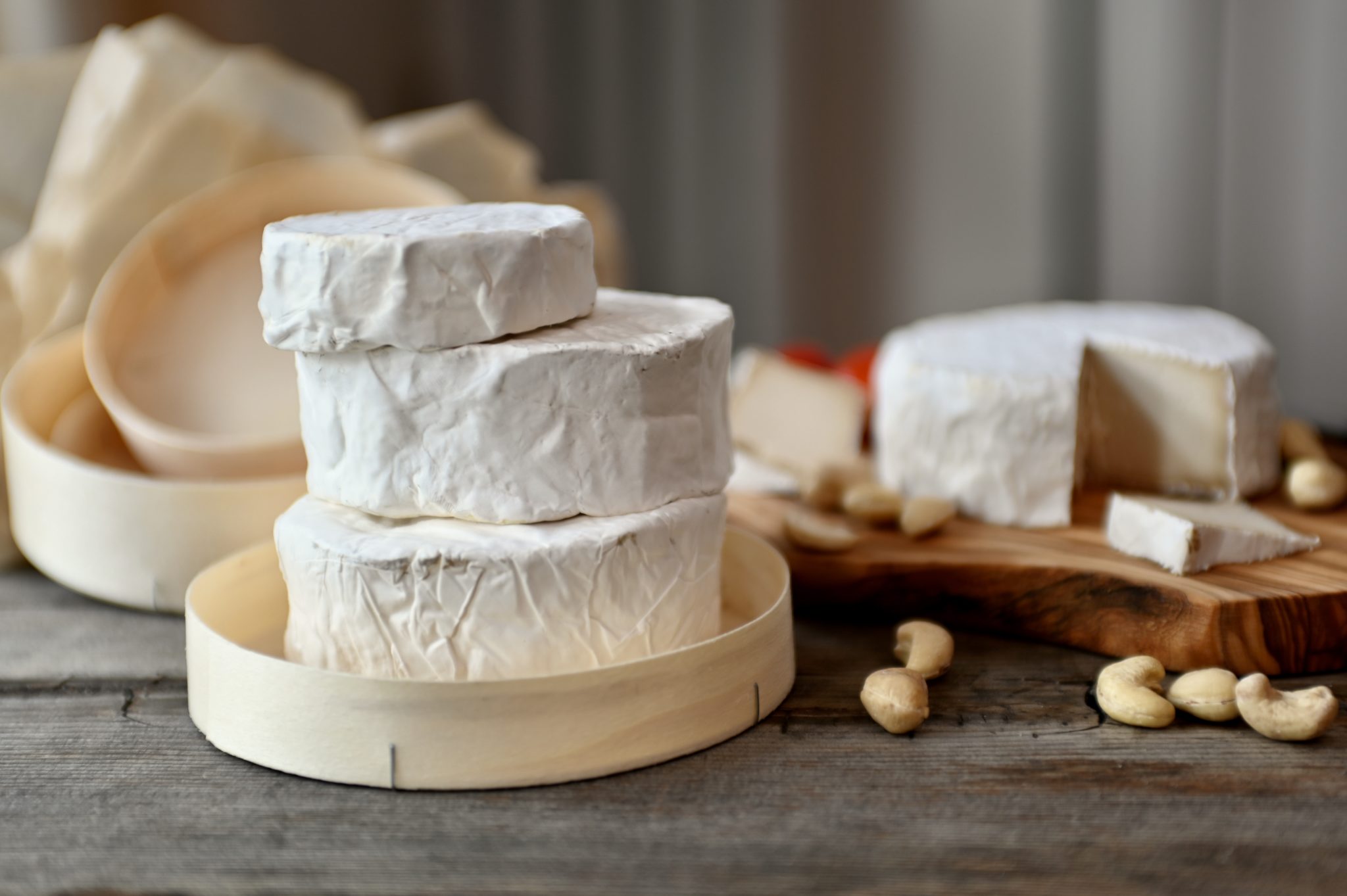
vegan cheese (cashew camembert)
Take a bite of this Vegan Cheese and you’ll be amazed that it’s not dairy cheese. Not only does it look exactly the same, but it also tastes the same–even better!
Knowing how much the dairy product industry impacts our health and the environment, my family cut down dairy product intake by more than 80% over the past few years.
Whenever I talk to people who are trying to go plant-based, most of them say the same thing: that giving up cheese is the hardest.
It was hard for me too. I started to look into it more seriously to find something to replace the dairy cheese we ate. Unfortunately, most Vegan Cheeses on the market are highly processed and the tastes are unbelievably bad.
So, I began to research and experiment with making my own Vegan Cheese in 2017. Without much success, I gave up and put the project on hold. I then cut down on our other dairy consumption instead.
Time went by, but the idea of making Vegan Cheese was still on my mind. I began to look back, and still wanted to find ways to make it happen. This time, I stumbled on two websites on how to make Vegan Cheese from cashews. One is Full of Plants and the other one is Cashewbert.
They sparked up my hope again. So, I combined their methods, and adapted them to make my own. Thank you both so much!
The process of making Vegan Cheese involves fermentation, and since I already make so many fermented foods– this Vegan Cheese is perfect for me.

enjoy this vegan cheese with fruits & vegetables
Like most fermented food, making this Vegan Cheese takes time and patience. It has to go through the fermentation period to let the mold grow–the mold is the key to make the cheese taste so good. Then it has to go through the aging period to develop the flavor inside.
As I do other things that take longer time and patience such as soy sauce and apple cider vinegar too, this works fine for me. The actual work is very minimal, but the hardest part is waiting.
For the first few tries, my Vegan Cheese didn’t look good, but the taste was amazingly good!
Since I knew the taste was so good, I was so happy and kept making it. I’m proud to say that over time, my cheese now looks very appealing.
This Vegan Cheese is not only beautiful and flavorful, but it’s also fun to make, and I really enjoy that so much.

beautiful white mold
Working on this Vegan Cheese is like working on a piece of fine art. Seeing good results each day during the process makes me want to make it better and better each time.
I am now confident with the recipe I adapted and ready to share it with you. I tested this with my relatives over the holidays, and everyone was impressed with its flavor.
Ready to leave dairy cheese behind and start making Vegan Cheese? Let me show you how!
Note: Please be aware that this process takes about 4 to 5 weeks from start to finish, or even longer. However, you can start eating it after week 3 even though the flavor has not yet fully developed. If you want it to be sharp, eating it around week 5 or later is perfect. Trust me, it’s really worth the wait!
Ingredients for making Vegan Cheese:
This recipe makes 1 perfect size of a small springform pan (1 ½ x 4 inches) and a little extra to make a small one. Note: I started making this recipe by using a high-speed blender. As it’s very hard to get all the mixture out of the blender, I ended up with the perfect amount to make one perfect size cheese using a small springform pan as a mold. Now, that I use a food processor instead, I can get all the mixture out easily. However, I end up with extra mixture to make a small cheese. You can divide this recipe to make 2 normal size cheeses instead.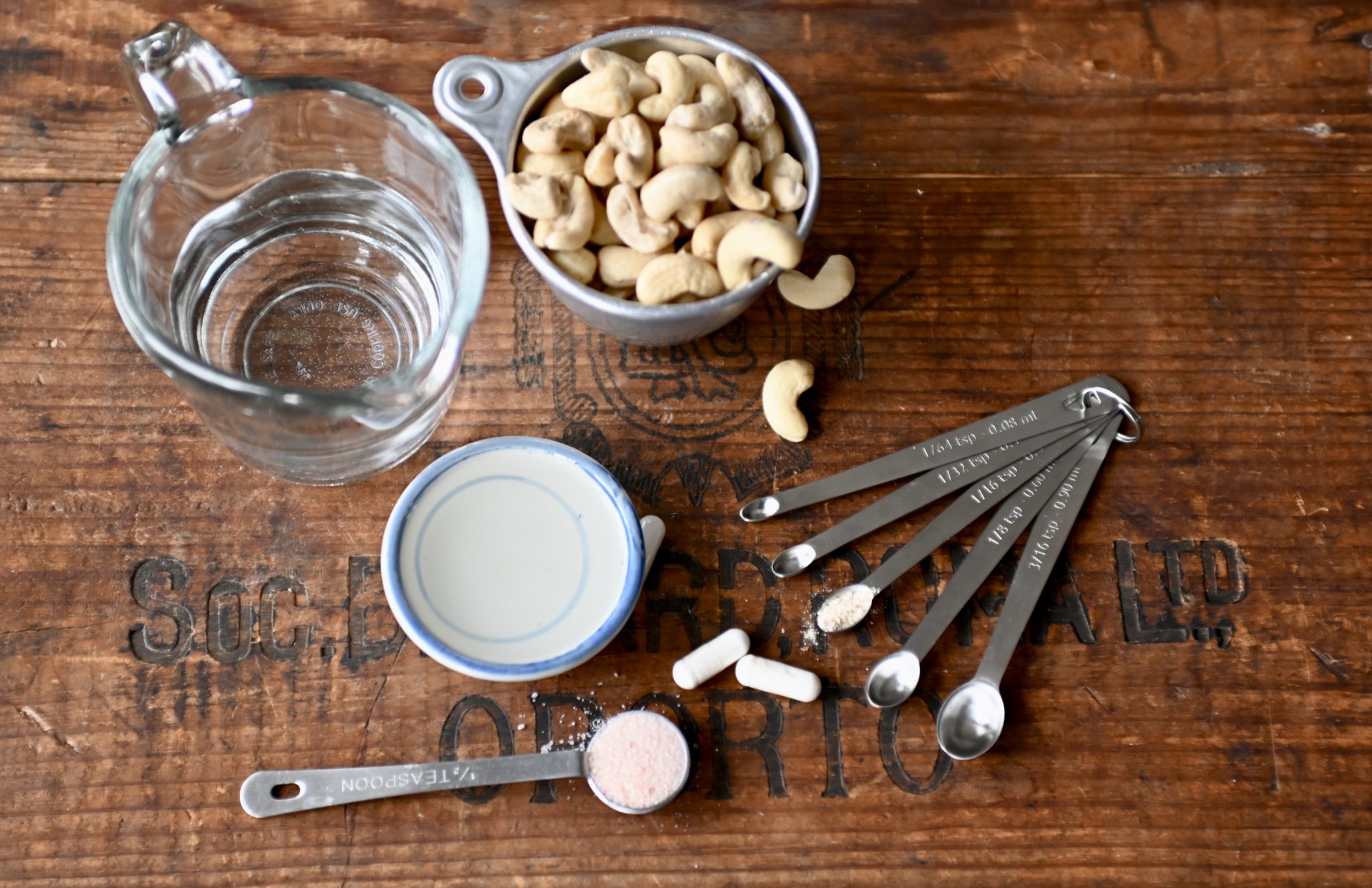
- 2 cups (474 ml) of raw cashews, organic is preferable
- 4 capsules of plant-based probiotic. You can get them at most health food stores.
- 4TBSP (60 ml) of water kefir (optional) If you don’t have it, substitute the same amount of filtered water instead.
- 3 TBSP (45 ml) of filtered water
- About ½ TSP (1.25 ml) of good salt
- 1/16 tsp (Dash) of Penicillium Candidum. Note: Most Penicillium Candidum sold in the US is from dairy, so be sure to get the right one. I have found a company in the US that has a vegan option, and another one is in Europe cashewbert, but unfortunately they don’t ship worldwide (not affiliated).
Equipment:
Note: Use this is for guidance, and feel free to use what you already have and be creative!
- A food processor or a high speed blender. Note: I tried using a high speed blender a few times and realized it was too difficult to scoop out the cashew paste. To make it easier for the blender to work properly and easy to scoop, I had to make the paste liquid enough. I ended up with another process to get rid of the liquid, and the cheese didn’t turn out the way I wanted. So, I’m happy using a food processor as it’s easier.
- Something to form the cheese. I use a small non-stick springform pan and a custard bowl.
- A container to use during the aging process.
- 2 bamboo mats or any non-metallic rack.
- Cheesecloth (washed) and parchment paper.
Instructions:
- Day 1: soak the cashews in filtered water overnight.
- Day 2: dump the soaking water, and replace it with new filtered water. Strain and let the water drip. Note: You can quickly pour boiling water over it and rinse it if you prefer. (that’s what both websites I learned from recommend)
- Put the cashews in a food processor, (or a high-speed blender) add ¼ teaspoon salt, water kefir and filtered water. Process, scrape down, and keep processing until smooth to the texture you like.
- Open the probiotic capsules and sprinkle the powder in, and add Penicillium Candidum. Process it again until everything is well combined.
- Put the mixture in a glass container, cover it lightly and let it ferment at room temperature for one night.
- Day 3: use a container’s lid, put a bottomless springform on it, then put a cheesecloth in. Scoop the mixture into it and lightly pack it down. Fold the cheesecloth over the edges and gently press it down to smooth mixture. Use the container to lightly cover it, and let it sit in the coolest area of the house (I leave mine in the attic and it works perfect), and let it form for one night.
- Day 4: take out the form and unwrap the cheesecloth. Sprinkle some salt on it evenly, then use a piece of parchment paper to cover it and carefully flip the cheese. Remove the cheesecloth and sprinkle salt on this side too. Cover it and put it back in the cool area. Note: the amount of salt used to sprinkle is about ¼ teaspoon (1.25 g), but don’t worry if it’s a little bit more or less.
- Day 5-10: use a piece of dried parchment paper to flip it every day. You should see some signs of white mold around day 6 or 7. During this period, the cheese sweats, so make sure to dry any moisture on the cover before covering it up each time. Note: I wipe down the paper with a clean washcloth after each use, dry it. I reuse the same paper until it gets too weary to use. If you forget to flip and let the cheese sit on the paper longer than one day, the paper will stick to the cheese and it’s hard to remove it without damaging some mold. The mold is essential to protect bad mold growth inside the cheese. I damaged my a few time to learn this problem. So, be sure to flip and change the paper everyday.
- Day 11 or so: the cheese is should now be covered with white mold and firmer. It’s also easier to flip. Replace the paper with a bamboo mat or a non-metallic rack. The bamboo mat helps to ventilate the cheese better. Still, flip it each day, but at this point it’s ok if you forget to flip it on some of the days.
- Day 16 or so: the cheese is now covered with thick mold, and it’s time for slow aging. Transfer the cheese to a piece of parchment paper and wrap it. Put it in a breathable container and keep it in the fridge to age for another 2 to 3 weeks . No need to flip it at this point.
- After 2 weeks or so of aging in the fridge, it should be ready to eat. The cheese is now dry and firm. Enjoy! Note: If you plan, and repeat making it accordingly, you can always have Vegan Cheese on hand.

soak cashews with filtered water for one night
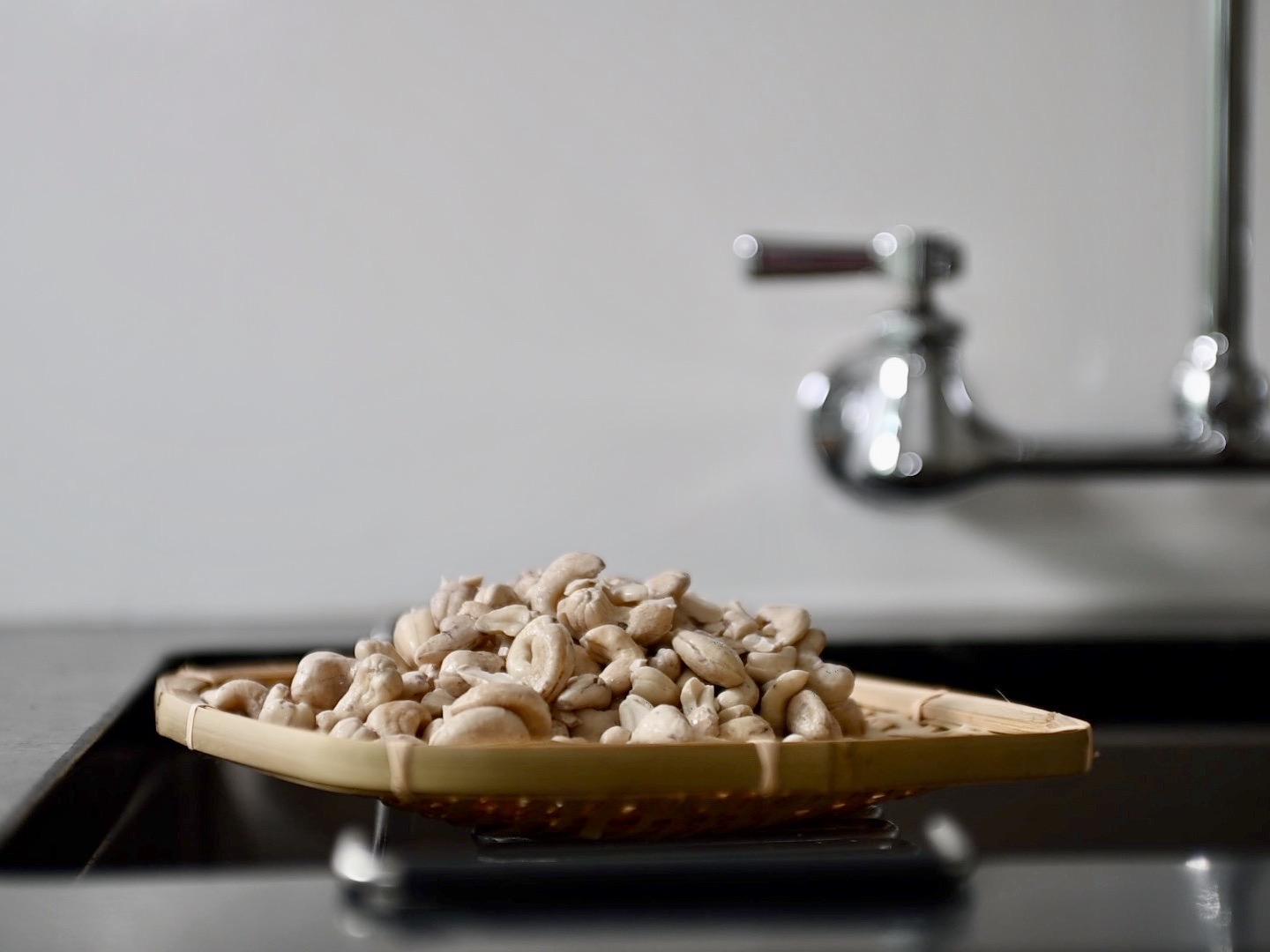
strain and let it sit until the water stops dripping
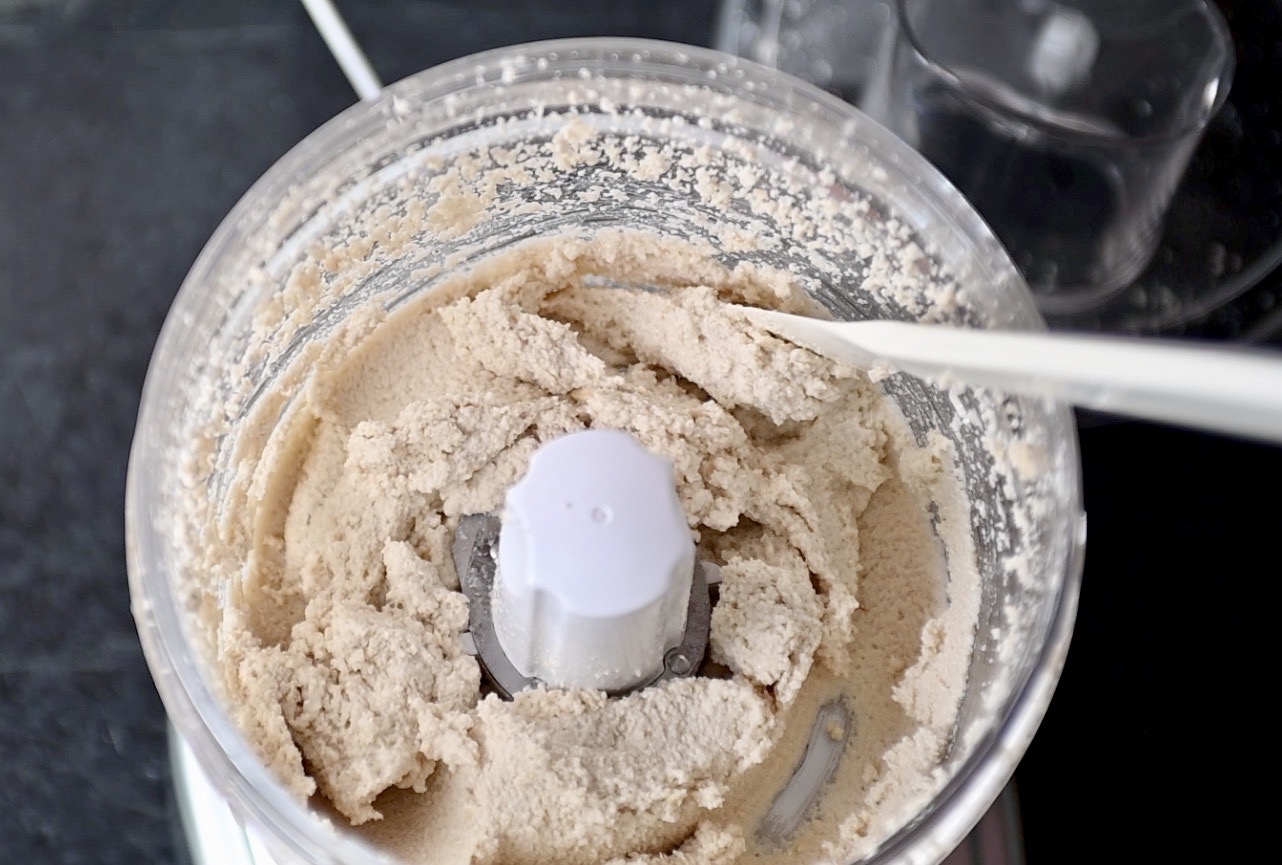
process until smooth
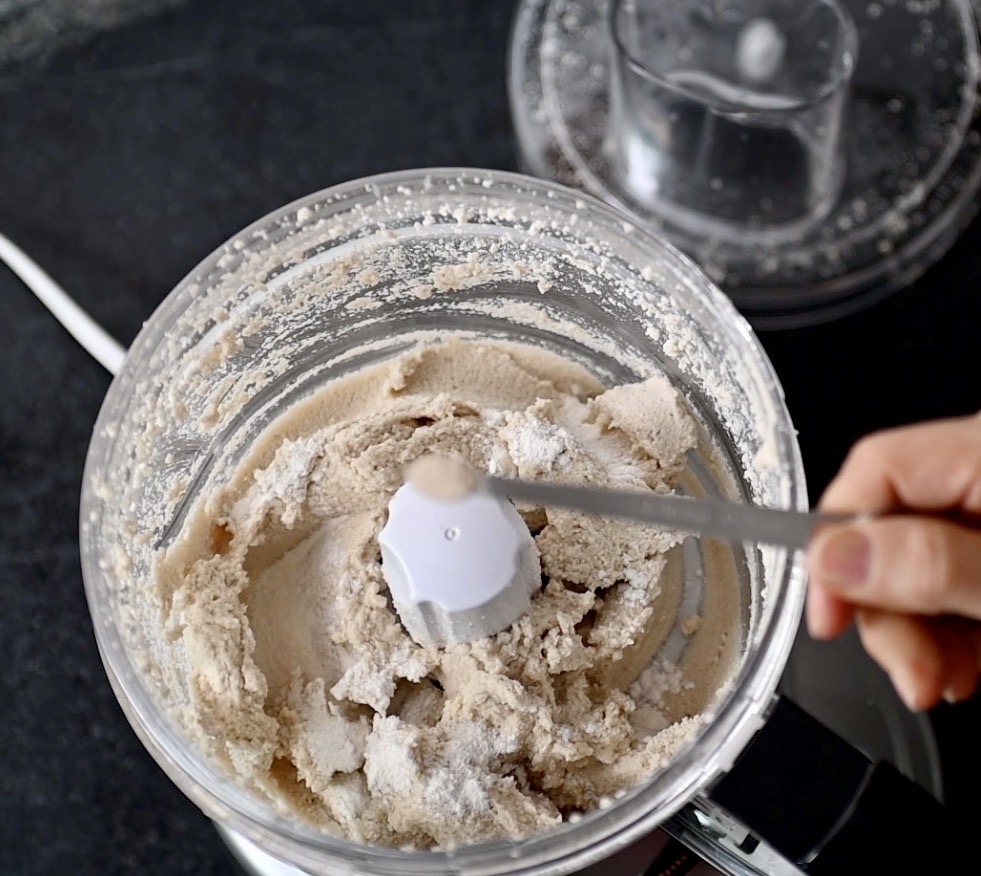
add probiotics and penicillium candidum
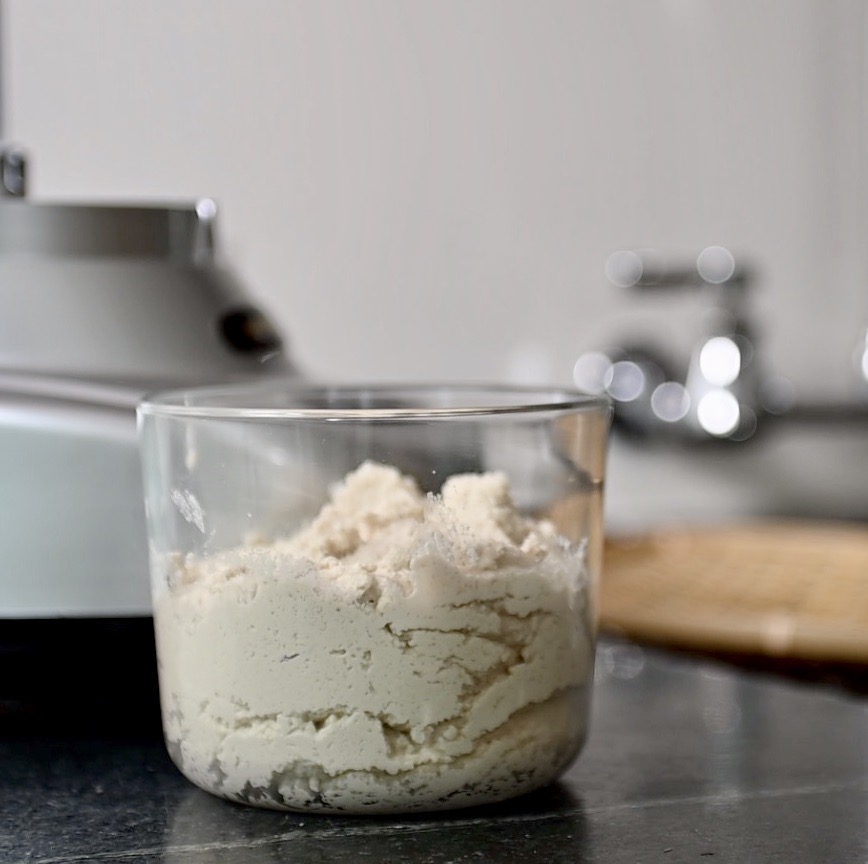
put the mixture to a glass container to ferment
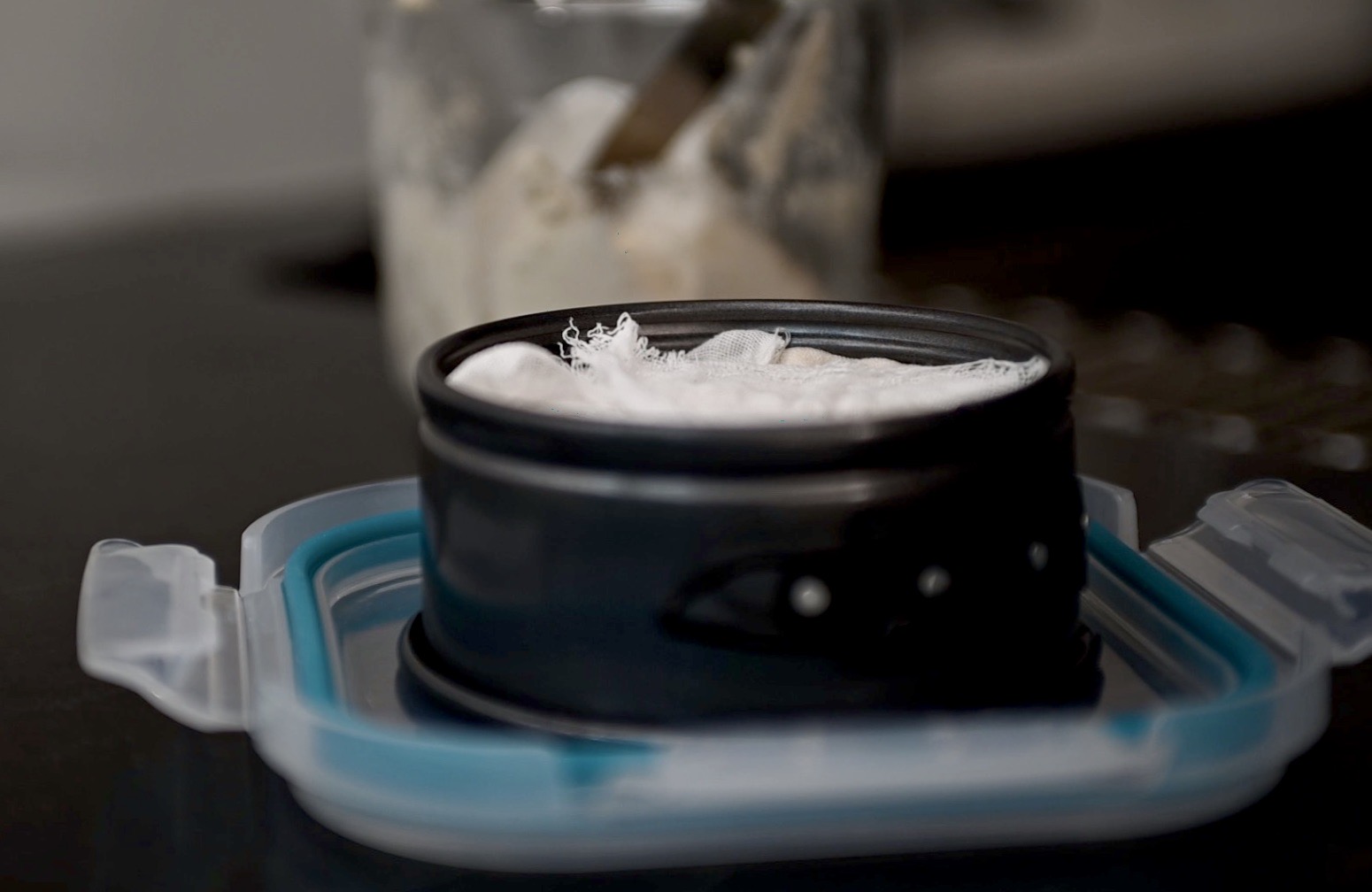
use a small springform pan with a cheesecloth to form the mixture
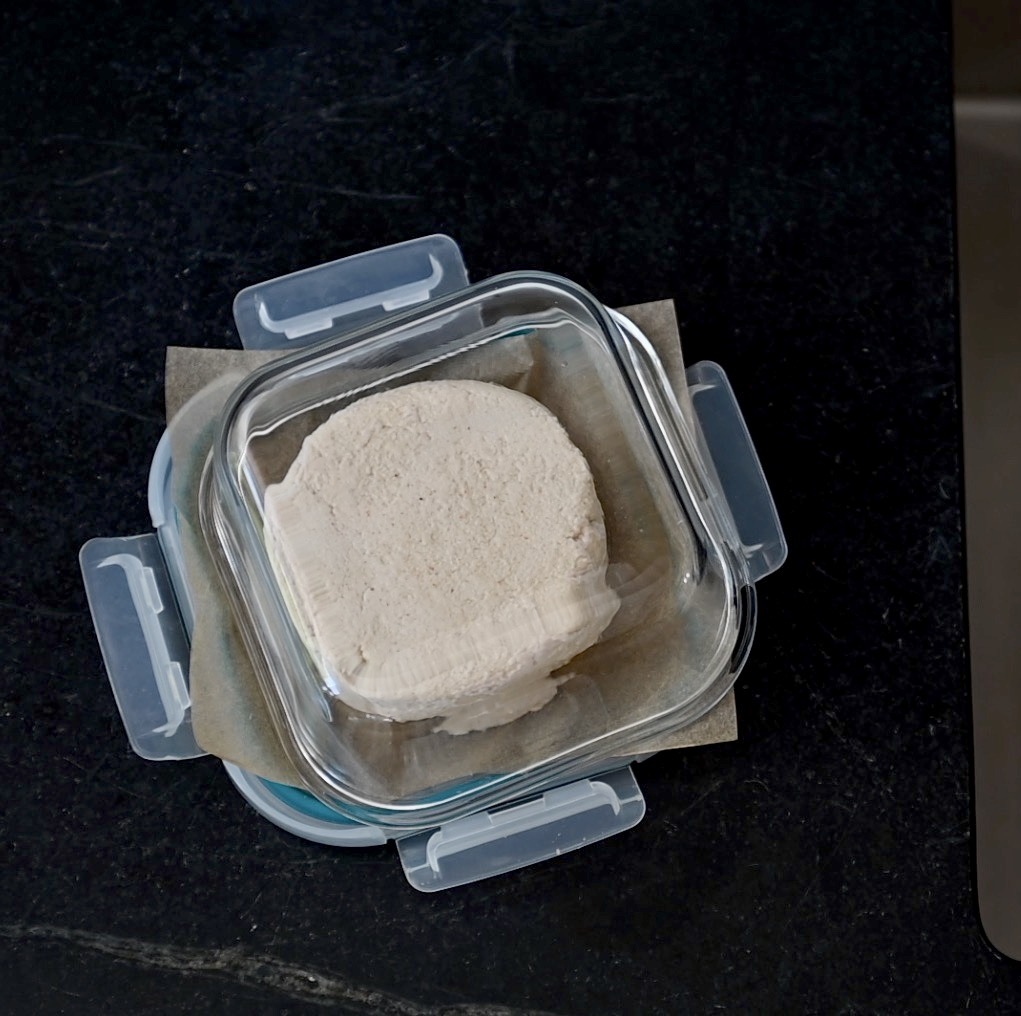
loosely cover it and leave it in a cool area

the mold starts to grow by day 6 or 7
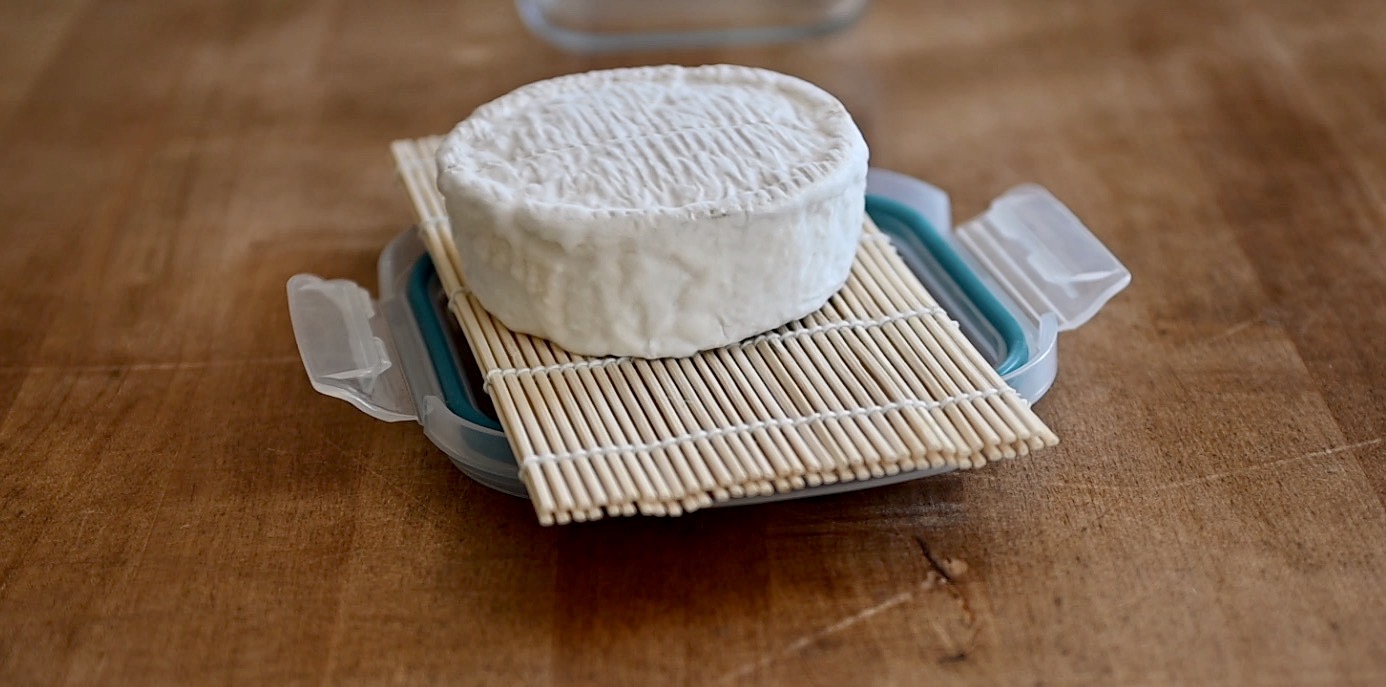
let the cheese age on a bamboo mat
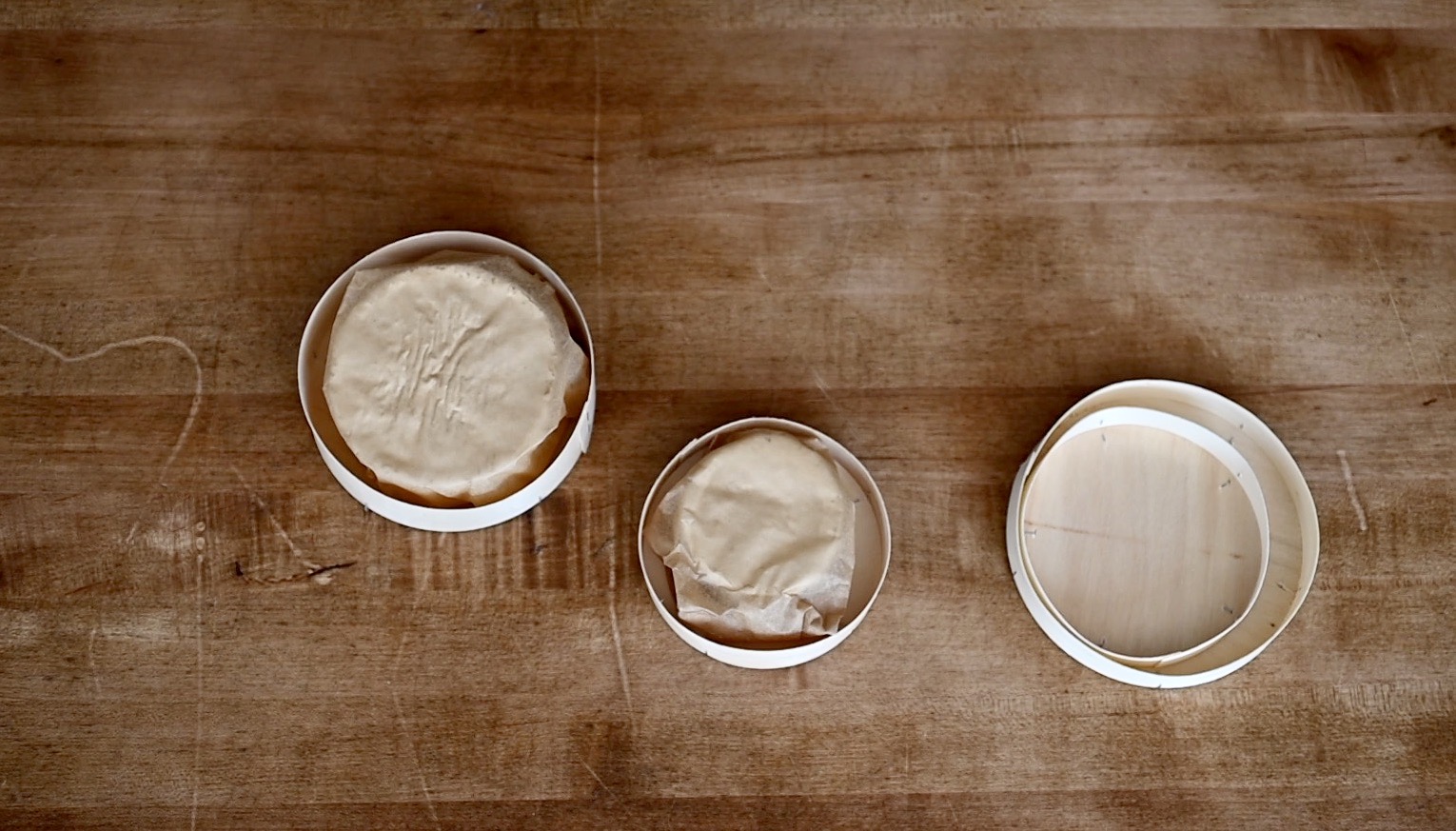
wrap it with parchment paper and store it in breathable container for slowing in the fridge
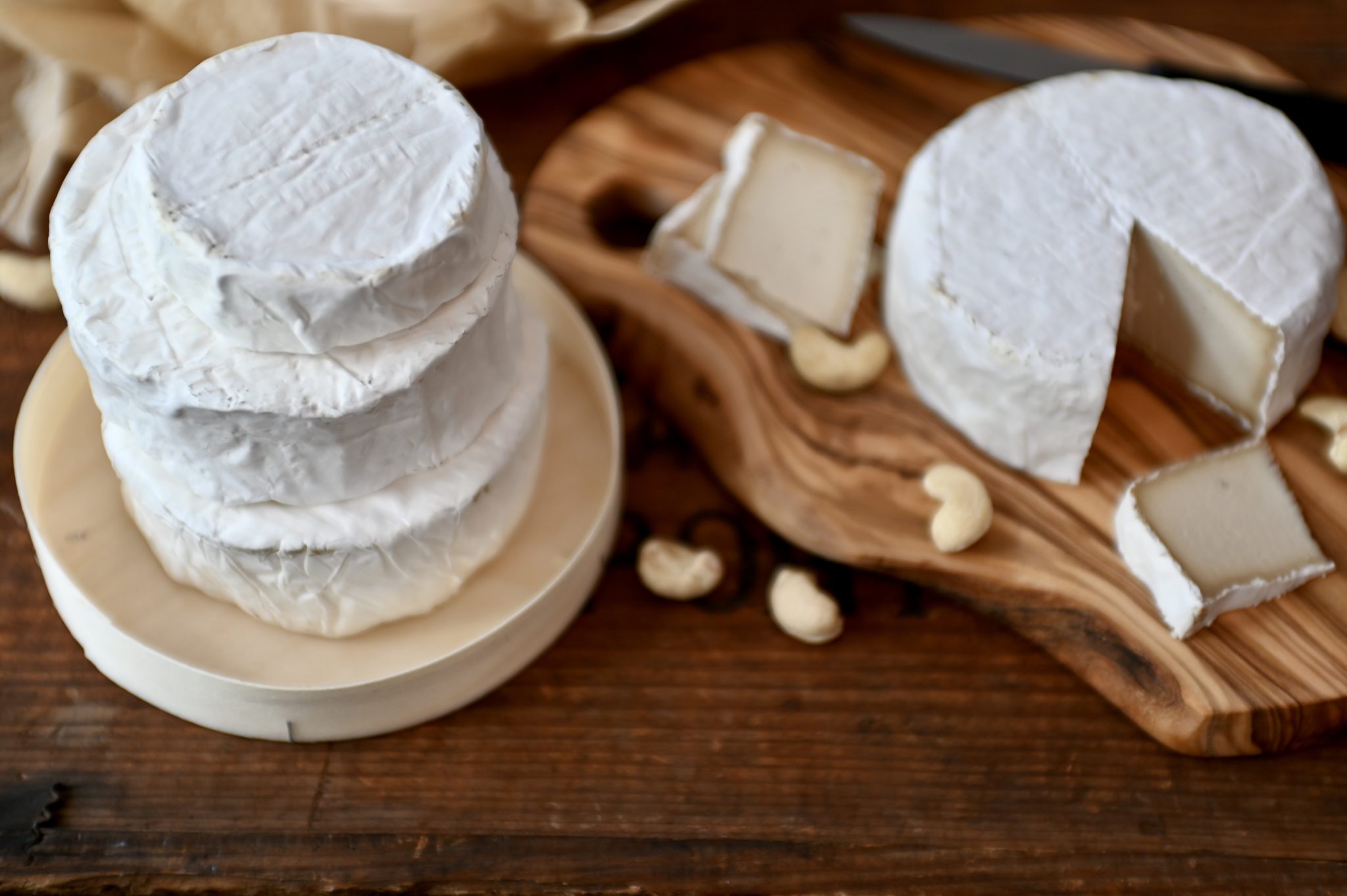
enjoy!
Have you made Vegan Cheese before? Please share it with me, I’d like to hear about it!
When I blended it it looked really liquid even though i measured all the ingredients. On day 4 it was still too soft to remove from the dish. Should I leave it there a few more days to harden before umoulding? And then start the turning and salt process?
I’m wondering why too. I think you should unfolding it to let it expose to some air. It might help, but make sure to be very gentle. I hope it works.
I love your blog.. very nice colors & theme.
Did you make this website yourself or did you hire someone to do it for you?
Plz reply as I’m looking to construct my own blog and would like to
know where u got this from. kudos
Thank you for sharing your recipe and I really enjoy watching the video!
I’ve started making my own cashew camembert according to your recipe but I don’t have a room cold enough to store them so I use my fridge. I’m on day 8 and I still don’t see any mold on my cheeses.
Is it the cold? Should I place them in room temperature instead? Please advice!
Yes, I think the fridge is too cold for the mold to grow. Try leaving it at room temperature until you see some mold growth and move it to the fridge. Please let me know.
I just ordered from the cheese maker! They recommended also using Geotrichum Candidum to make sure the mold is thick. Have you ever tried that?
Also, how long does this keep for before it goes bad?
I only use penicillium candid and always get thick white mold. If you don’t cut it open, it stays fresh for a long time. However, if you already cut it to eat, try to finish it within a week.
Wonderful what you created here!
I started the camembert 2 weeks ago. everything went good so far. a few days ago some little green mold spots became visible, so I scraped it off. But it´s coming back every day. Only on the top and bottom, the sides are nicely covered with white mold.
So to reproduce it correctly what is the source of error. Equipment not sterilized? Too humid the first days (in the beginning I forgot to delete moisture)? Or why did P Candidum only establish on the sides?
Thank you! I just want to continue with progress 🙂
It happened to me a few times when I forgot to flip it. The mold grew onto the paper and I damaged it when I was trying to remove the paper. When the white mold was damaged, I saw some fuzzy green mold too –that’s the only thing I have experienced. The mold tends to grow slower on the top and bottom as it gets less air flow, but it does eventually. Please try again!
This looks great! Do you have any comment regards Puritan’s Pride Probiotics? Thanks again Jeem!
Looks amazing, have you tried using rejuvelac for the culturing agent instead of the probiotic cultures?
I just started making the cheese and now realized I don’t have a place with your recommended temperature…
Would you rather keep the cheese in the fridge (around 7 degrees) or at room temperature (around 18 degrees)? I don´t have an attic but am afraid that the mold won’t grow when I keep it in the fridge since its too cold…
Thanks in advance!
This is a great question and I have the same one! Following to hear the response
Thank you for the generosity of share this recipe! I saw the video and right away searched the web for penicillium candidum. I found a store and the price is very affordable. And here in Brazil cashew we find everywhere. I’ll make this cheese because my Italian genes ask daily for cheese, and I don’t want to break my veganism. Thank you so much!
I checked out the Cashewbert web site and purchased their vegan cheese book. In their recipes they use mesophilic starter which I still have in my freezer from my dairy cheese making days. Have you tried this instead of the probiotics? Currently I’m on day 5 using probiotics and will try the mesophilic with the next batch in a week or so. I’ll post here with my results once I have them.
Hi Jeem. The cheese looks so good ! Do you have an idea of what is the room temperature for you ? I would like to try making it but I am in the Philippines so I am worried it’s gonna be to hot here… thanks a lot !! 🙂
I keep my house about 68 degrees Fahrenheit (20 degrees celsius) but I turn it during the night and sometimes it goes as low as 60 degrees.I’m sure it should be fine if it’s not exactly the same. I’m so glad to hear that you like to give it a try!
My spouse and I stumbled over here coming from a different page
and thought I might check things out. I like what
I see so now i am following you. Look forward to exploring
your web page repeatedly.
Hello Ms. Jeem! I’m so excited to make my own cashew Camembert but I’d like to ask if what could be an for penicillum candidum?
Hi, I really liked your video and really want to try making the cheese myself now 🙂 I recently went vegan and although cheese was the one thing that I missed most, I now got used to vegan cheese and even started liking it, so I’m really intrigued by this recipe. I have once question regarding Penicillium Candidum; is this the same type of penicillin found in medicine? I’m allergic to it so in case it is, would there be an alternative? Thanks 🙂
Hi! I have the same problem and found this info on wikipedia:
“Penicillium camemberti is a species of fungus in the genus Penicillium. It is used in the production of Camembert, Brie, Langres, Coulommiers, and Cambozola cheeses, on which colonies of P. camemberti form a hard, white crust. It is responsible for giving these cheeses their distinctive flavors. An allergy to the antibiotic penicillin does not necessarily imply an allergy to cheeses made using P. camemberti.[2]”
Binomial name Penicillium camemberti
Synonyms[1]
Penicillium album Epstein (1902)Penicillium rogeri Wehmer (1906)Penicillium caseicola Bainier (1907)Penicillium biforme Thom (1910)Penicillium candidum Roger (1923)Penicillium paecilomyceforme Szilvinyi (1941)
Hi!
Question about the amount of cashews needed: 2 cups for me is nowhere near 440g. I weighted 2 cups (with a measuring cup) and it’s about half that.
Not sure if I go with the cup measure or the weight measure.
Yes I am sorry I must have made a mistake. By volume, 2 cups should be little less than 1/2 liter (474 ml). I went in and fixed it on my blog. Thank you so much!
Hi! Looks amazing, I might give this a try! I was wondering if this can be firmer or runnier if you adjust the recipe slightly…I like a runny, creamy camembert. Have you experimented with that? Thank you!
Can you tell me where you get your containers to hold the during aging? Thanks.
Hey! Loved the video, I would love to know where the little bamboo baskets you keep the cheese in from?
I saved them from when I bought dairy cheeses a while ago.
Hi. Can I skip the probiotic? Because I don’t have this ingredient in my country.
The probiotic is the ingredient that ferments the cheese. You cannot make this cheese without it.
Sawatdee Ka
I fell upon your cheese and I am so glad I did! Hello from
Melbourne 😊
Sawasdee Ka!❤️
Do you eat the white mold part?
Haha I am so thankful someone else was wondering this! Following for reply lol.
But of course!! 🙂
yes, I do.
Hi and thank you for your AMAZING video, it mesmerized me 😍
I found vegan probiotics and penicillin cand. on this German site https://www.kaese-selber.de/produkte/kulturen/ the probiotics are the yogurt culture one?
It works fine?
Thank you so much, it’s an inspiration!
You’re very welcome. Thank you for sharing the links!
Hi Jeem,
Can you please tell how many degrees was in the attic? 🙂 Between day 5-10 was it still in the attic?
I looks really good, I hope I can try it soon. But it must be hard to wait so many weeks for it! 🙂
Thanks, Renata
Hi Renata, my attic is usually about 53-56 degrees Fahrenheit (11-12 degrees Celsius) more or less. I really hope you will try making it soon. Yes, it’s a little bit hard to wait but it’s really worth it.
How well does it keep and can you freeze it?
I haven’t done freezing it before, so I can’t tell for sure, However, I’m pretty sure you can freeze it.
Hi, Jeem! I am SO HAPPY that I found your cheese-making video! I’ve been wanting to try this method for a while but got scared off when I heard that you need a special ‘cheese aging fridge’ to keep the temperature consistent. Since your instructions don’t have this requirement, I’m going to try! I just have one question though, when you say to put the cheese in the ‘coolest place in your home’, what temperature does it need to be at? I live in Canada and it’s winter right now, so the temperature can get pretty low. I just want to make sure that I do this right the first time! Thanks in advance 🙂
Hi Hosana, I’m so happy you found my video. I was once intimidated by the special fridge too, but decided to give it a try aging it in my attic. It worked so well, and I was so glad I did. The temperature in my attic is usually about 53-56 degrees Fahrenheit (11-12 degrees celsius) depends on the temperature outside. I learn that if it’s cold, it takes longer time for the mold to grow–but it will. Good luck making this cheese, it’s really worth the effort!
Many salts have iodine in them and iodine seems to inhibit the mold formation. It took me a long time to figure this out because i was using sea salt and didn’t realize that the brand i was using had iodine added. Best to use a non iodized salt.
Thanks for the visuals.
Laurie, thank you for the info, it’s really good to know. I usually use pink Himalayan salt for cooking and just use it for making this cheese too, and I’m glad it works.
What is the nutritional value
I’m so sorry I don’t know much about the nutrition value, but I think you get the same as what you get from eating cashews.
Hi!!! I really want to try thia recipe!, Two questions, instead of using kefir water, could we use jun water? Jun is similar to kombucha. And two, what do you mean that some Penicillum candidum is “from” dairy? It means that is for growing in dairy products like milk, or it means it was produced from dairy products? Thank you, and the Best Wishes for this 2020!!!
I did some research and contacted a company ( The CheeseMaker –not affiliated) before I started to make it to make sure that I call it vegan. I found out that non vegan penicillium candidum is grown on lactose, so it has traces of dairy lactose–very little. I haven’t made it with other kind of fermented drink before, but I’m pretty sure it should work.
Hello
I have a short question if you dont mind
Is this camenbert meltable because one thing i really miss since going vegan are those backed camenberts and i was wondering if it is possible to make those with this vegan option 🙂
By the way your video was amazing and truly calming to watch thank you very much:)
Hope you are having a great time
Jana
No, it doesn’t melt like dairy camembert. I usually eat it with crackers and fruit as a snack. I got this question a lot so I tried melting it with a piece of bread, but it didn’t. Thank you so much for your compliments.
Wow nice. Thank you for sharing. I had made vegan cheese before and it was nice. Let’s see if I have the patience to do this soon. I might have a shorter processing time as I leave in a warm country. Thanks again. Also I feel fine with the music. I felt therapeutic watching you making it with the music.
You’re very welcome. I hope you make it soon too. Thank you so much for your kind comment!
There are several types of vegan probiotic capsules and powders. What type did you use?
The one I use is Jarro-Dophilus Allergen Free 15 Billion. I buy it from a health food store in my area.